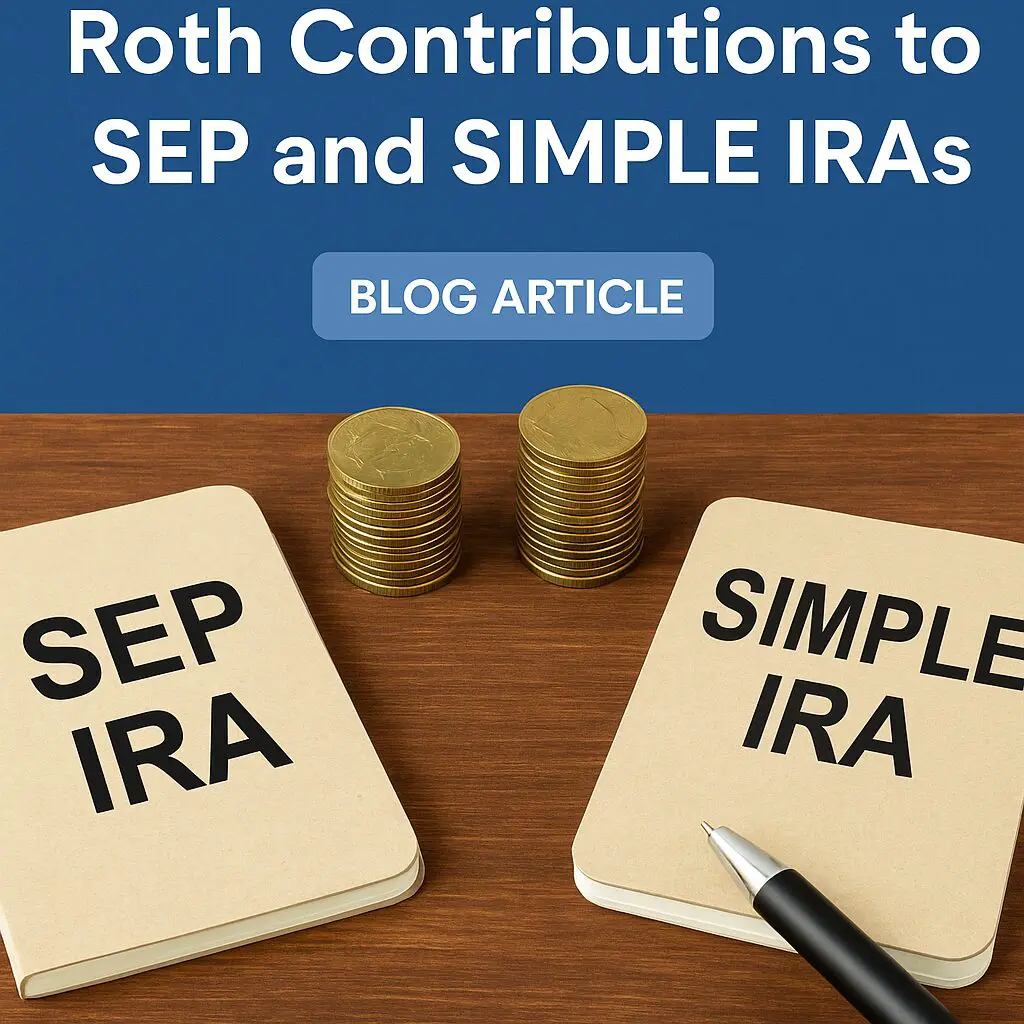Roth Contributions to SEP and SIMPLE IRAs (Post-SECURE 2.0 Updates) Unlocking New Possibilities in Retirement Planning
The SECURE 2.0 Act of 2022 has introduced pivotal changes for SEP and SIMPLE IRA account holders. One of the most impactful updates? Participants can now make Roth contributions to their SEP and SIMPLE IRAs, a game-changer for retirement planning. As of January 1, 2023, employees in eligible plans can designate salary deferrals and employer contributions as Roth contributions, providing more flexibility and personalization in how retirement funds are managed.
Here’s everything you need to know about the updates, their benefits, and how to take advantage of them.
What Changed Under SECURE 2.0?
Before the SECURE 2.0 Act, SEP and SIMPLE IRAs could not accept Roth contributions. However, Section 601 of the act repealed these restrictions, allowing employees to designate contributions as Roth amounts. This applies to both salary-reduction contributions and employer contributions, such as matches or non-elective payments, provided the plan permits it.
The IRS has already issued guidance through Notice 2024-2, confirming the eligibility of Roth contributions for SEP and SIMPLE IRAs. While this option is not mandatory for employers to offer, it adds an attractive layer of flexibility for those seeking to maximize their retirement strategies using after-tax contributions.
Roth SEP and SIMPLE IRAs: Key Features
Roth contributions differ from traditional, pre-tax contributions in one significant way: they are made with after-tax dollars. Here’s a closer look at the most important rules and benefits associated with these accounts:
- After-Tax Contributions
- Roth SEP and SIMPLE IRA contributions are non-deductible. Employees will include these contributions in their gross income for the year they are made.
- Both salary deferrals and employer contributions are subject to this after-tax treatment.
- Contribution Limits
- SEP IRAs allow contributions up to 25% of an employee’s compensation, up to the annual limit ($66,000 in 2023).
- SIMPLE IRAs permit salary deferrals of up to $15,500 for 2023, with an additional $3,500 catch-up contribution if you’re 50 or older. Employer contributions also follow SIMPLE plan rules.
- No Retroactive Elections
- Roth contributions must be actively elected by the participant before the contribution is made. Retroactive designation is not an option.
- Tax-Free Growth Potential
- Like Roth IRAs, Roth SEP and SIMPLE IRAs offer tax-free growth and tax-free qualified withdrawals, assuming applicable age and holding period requirements are met.
Why Choose Roth SEP or SIMPLE Contributions?
Roth contributions to SEP and SIMPLE IRAs are ideal for those wanting to minimize future tax burdens. Below are some scenarios where Roth contributions can shine:
- Younger workers in lower tax brackets often see long-term benefits, as their contributions grow tax-free and withdrawals are tax-exempt.
- Professionals expecting higher tax brackets in retirement can lock in current tax rates.
- Those who prefer flexibility and want to diversify their retirement income sources with both pre-tax and post-tax options.
Pairing these accounts with more traditional options creates a well-rounded retirement strategy that balances immediate tax benefits with tax-free growth opportunities.
IRS Guidance and Reporting
To implement these changes, the IRS has updated key reporting forms and instructions. Notably:
- Employee Roth contributions to SEP or SIMPLE IRAs are treated as wages and must be reported on Form W-2 using codes F (for SEP) or S (for SIMPLE) in Box 12.
- Employer Roth contributions are not subject to payroll taxes but must be included on Form 1099-R for the participant’s income reporting, with the appropriate distribution codes.
Employers offering the Roth option should ensure their payroll and recordkeeping systems are equipped to handle these new reporting requirements.
How Employers and Employees Can Prepare
Employers can start by reviewing their SEP or SIMPLE IRA plans to decide whether to include the Roth contribution option in accordance with plan documents and IRS guidance. Employees, on the other hand, should:
- Confirm Availability
- Check with your employer to see if the Roth option is being offered under your plan.
- Make Elections Early
- Affirmatively elect Roth treatment during the standard contribution election period or before contributions are made.
- Understand the Tax Implications
- Recognize that Roth contributions are included in taxable income for the year.
- Leverage the Flexibility
- Add Roth contributions to your overall retirement strategy to achieve diversified tax treatment in retirement.
The Road Ahead
These Roth updates represent a significant leap forward for SEP and SIMPLE IRA account holders. Employers have until December 31, 2026, to formally amend their plans to comply with these changes, but Roth contributions can be allowed immediately without plan amendments, per IRS guidance.
For employees, the opportunity to take advantage of Roth SEP and SIMPLE IRAs is already here. By incorporating this powerful tool into your retirement portfolio, you can enjoy tax-free growth and withdrawals while taking control of your financial future.
Start Planning Today
uDirect IRA Services is committed to helping you maximize your retirement potential through self-directed retirement accounts. Our team of experts is here to guide you in navigating the complexities of Roth SEP and SIMPLE IRAs. While we don’t offer tax or legal advice, we provide the support and tools you need to make informed decisions.
Contact us today for a free consultation or open an account to start planning your tax-efficient retirement strategy with Roth SEP and SIMPLE IRAs.

